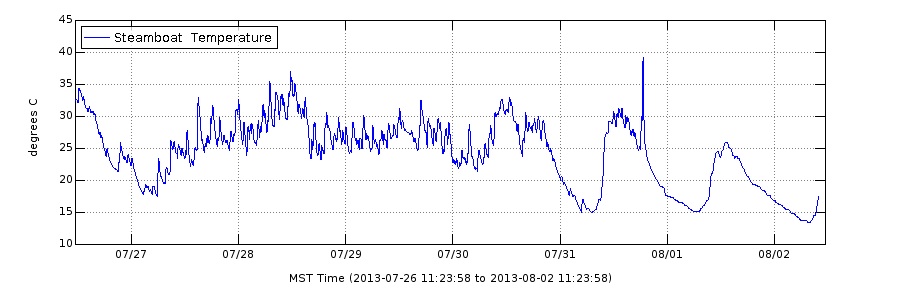
Yellowstone's Steamboat Geyser Roars to Life

Yellowstone's Steamboat Geyser erupted for the first time in eight years on Wednesday (July 31) afternoon, drenching delighted viewers who stood in the spray from the safety of a nearby boardwalk.
The unexpected blast occurred at 7:30 p.m. MDT (9:30 p.m. EDT), shooting water and steam 200 to 300 feet (60 to 90 meters) into the air. The spectacular display lasted nine minutes, but the steam continued through the night, said Dan Hottle, a spokesman for Yellowstone National Park. After the geyser exhausts its water supply, steam usually continues to vent for about 24 hours, he said.
Rare sight
Steamboat Geyser's eruptions are unpredictable but highly anticipated at the park, Hottle said.
"It's the favorite geyser of folks that come here and of park service employees," Hottle told LiveScience's OurAmazingPlanet. When active, the geyser may erupt every few days, jetting hot water as high as 400 feet (120 m), earning Steamboat the title of "World's Tallest Geyser." But the colorful vent can go years, or even decades, without an eruption.
About 30 to 40 park visitors saw the eruption, Hottle said. Viewers reported hearing a roar and feeling the ground shake, he said. Word spread quickly through Yellowstone, and by midnight, about 150 people were at the boardwalk next to the geyser, and the parking lot was full, he said.
Park employee Cindy Bredeson was one of the lucky few who saw the eruption in its early hours and shot video of steam pouring into the sky. "It was big enough that you can see it from miles away," Bredeson wrote on Facebook. "Got quite drenched as we walked up to it." [Watch Steamboat Geyser erupt]
Get the world’s most fascinating discoveries delivered straight to your inbox.
How a geyser works
The inner workings of Yellowstone's geysers are still inscrutable, though scientists are currently conducting studies with remote-sensing instruments to peer into the geysers' underground chambers.
Geologists now think a narrow conduit leads to the surface from a large, rounded underground cavern beneath geysers such as Old Faithful. Before a geyser eruption, water and steam become trapped and pressurized in the cavern. When the pressure below becomes too great, steam shoots water into the air through the conduit, creating a geyser's amazing fountains.
However, no one knows what triggers the eruptions at Steamboat Geyser, said Shaul Hurwitz, a research hydrologist with the U.S. Geological Survey in Menlo Park, Calif., who is studying Yellowstone's geysers.
"Most geysers are nonpredictable," Hurwitz told LiveScience's OurAmazingPlanet. "Those that are predictable, like Old Faithful, are quite rare."
In the past, geologists have tried to link Steamboat's explosions to outside forces, such as earthquakes and increases in yearly precipitation. But no one has found an external cause, Hurwitz said.
"We are still searching for clues for what would make it behave as it [does]," Hurwitz said. "As of now, we don't know."
About half of the world's 1,000 or so known geysers are in Yellowstone National Park.
Email Becky Oskin or follow her @beckyoskin. Follow us @OAPlanet, Facebook & Google+. Original article on LiveScience's OurAmazingPlanet.


